Recent Articles
Popular Makes
Body Types
10 Things You Need to Know About the Jeep Grand Cherokee Trackhawk
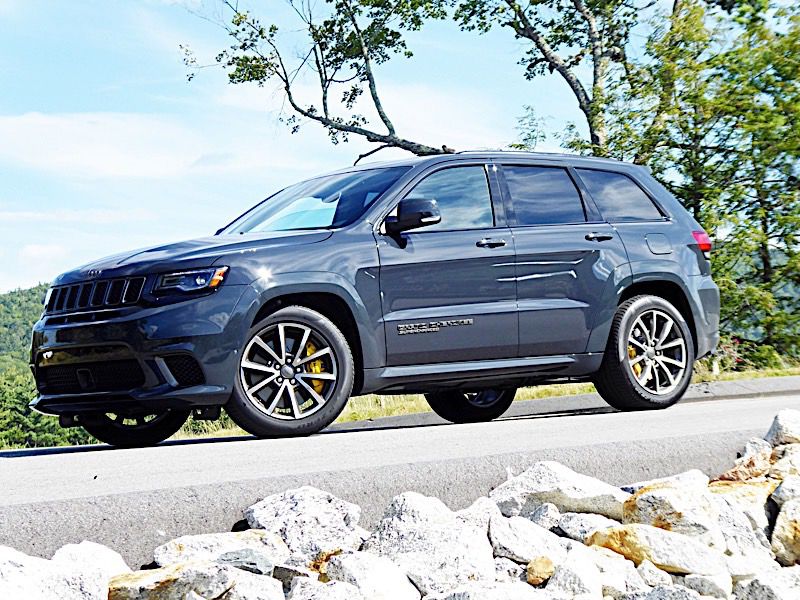
2018 Jeep Grand Cherokee Trackhawk front quarter hero ・ Photo by Ron Sessions
Does the world need a Jeep capable of 180 miles per hour? Of course not. That’s about as far afield as it gets from the spindly World War II-vintage four-wheel-drive machine that trudged through the mud and replaced the horse in the U.S. Army cavalry some 75 years ago.
But today, SUVs are mainstream family transportation and standing apart from the crowd requires some heroic measures. Enter the 2018 Jeep Grand Cherokee Trackhawk, a 707-horsepower sport-utility for those occasions when 706 hp just wouldn't be enough. At an MSRP of $85,900, the Trackhawk is both the most powerful and most expensive SUV in Jeep’s lineup.
1) It's supercharged!
At first glance, the new Trackhawk looks pretty much like any other version of the Jeep’s popular midsize SUV. It’s easy to overlook is the small “Supercharged” script on the front doors and door sills. That’s kind of how Jeep intended it — an understated exterior cloaking a muscular machine.
Yes, there’s a discreet winged “Trackhawk” badge on the liftgate. And if you listen closely out back, an authoritative burble broadcasts from the Jeep’s large-diameter quad exhaust outlets. But otherwise, there’s little to indicate the Trackhawk’s ability to storm to 60 mph from rest in 3.5 seconds or to run a standing-start quarter-mile in 11.6 seconds at a go-straight-to-jail 116 mph. That’s for you to know and wide-eyed drivers in unsuspecting Camaros, Mustangs and such to find out.
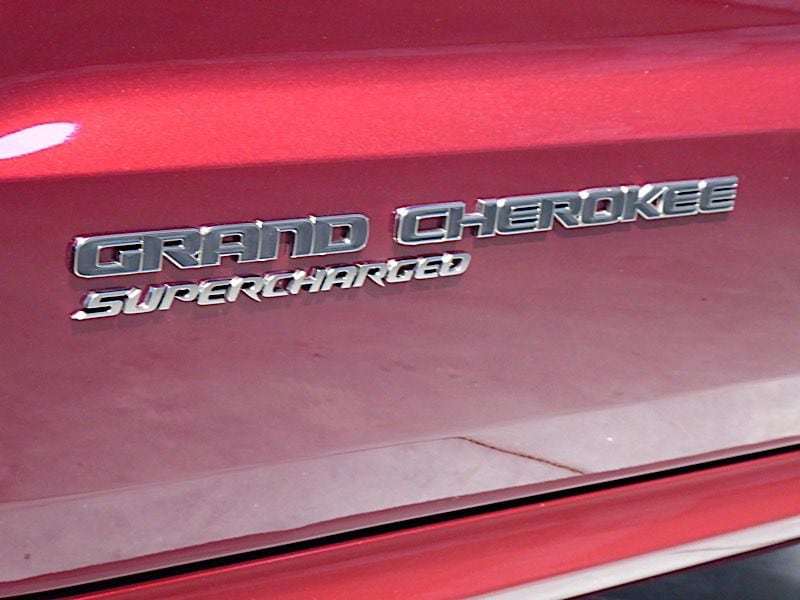
Photo by Ron Sessions
2) Yeah, it's got a Hemi.
As with the Jeep Grand Cherokee SRT that has “only” 475 horsepower, the new Trackhawk is powered by a famous Chrysler "Hemi" V8 engine. But lurking under the hood of the Trackhawk is the same 707-horsepower supercharged 6.2-liter Hemi that powers the bodacious SRT Hellcat versions of the Dodge Challenger and Charger.
The difference here is that the Trackhawk rolls with full-time four-wheel drive. So while an aggressive application of throttle from rest can result in a cloud of tire smoke from either of the rear-wheel drive Dodge muscle cars, the Trailhawk’s four meaty Pirelli 295/45R20s just stick like fly paper. Tromp the gas pedal and the Jeep suv charges off the line like a 300-lb NFL tackle sacking the quarterback. And you can do it all over again at the next traffic light, "Fast and Furious" style. No production SUV and very few cars will be able to pull a hole shot on your Trackhawk. Oh yeah, premium unleaded fuel is required, and EPA estimates are 11 mpg city/17 mpg highway, but something tells us fuel economy is not high on Trackhawk buyers' list of priorities.
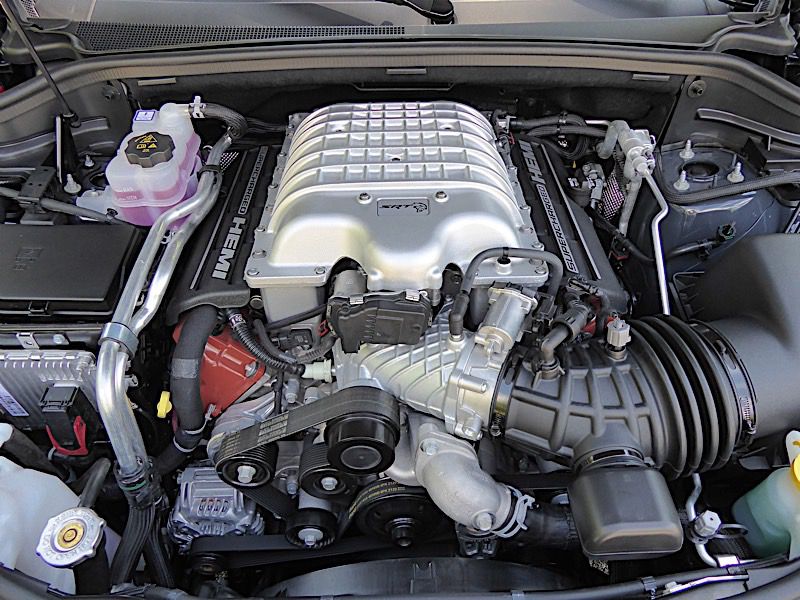
Photo by Ron Sessions
3) Inside, it's luxurious.
The Trackhawk’s cabin is a luxurious place. Our test vehicle was decked out in gorgeous Ruby Red stitched leather lining the seats, door panels, lower dash, console and center armrest— a $4,995 option. Up front are shapely sport buckets for the driver and front passenger that will heat or cool posteriors. They also add generous bolstering for reassuring lateral support, as this Jeep is not only a rocket in a straight line, but it can also turn and stop with moves that defy its 5,363-lb mass. The leather-wrapped steering wheel is heated as well and includes a power tilt-and-telescopic adjustment. The cabin is quiet, too, but the system lets in just enough supercharger whine when you squeeze on the throttle to let you know there’s some big action going on under the hood.
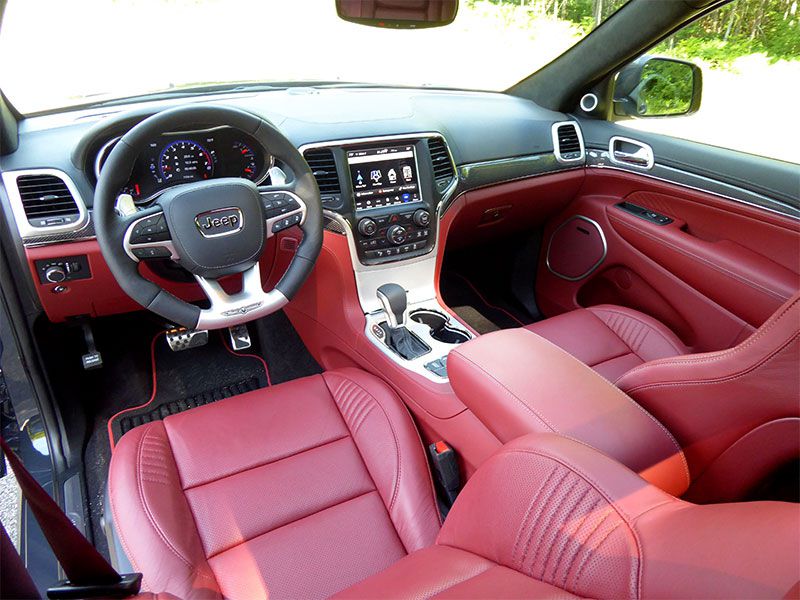
4) The back seat and cargo hold are accommodating.
Unlike some other SUVs, the Grand Cherokee does not offer third-row seating, but the Trackhawk's rear bench can seat three across. Standard fare includes seat heaters in the outboard positions, and the dual-zone automatic climate control system features back-seat outlets. Berber floormats are available, as is a dual-screen Blu-ray entertainment system.
Active noise cancellation keeps low-rpm engine rumbles from reverberating inside the roomy five-passenger cabin and big, 36.3-cubic-foot cargo bay. Fold down the 60/40 split back seat, and cargo space jumps to nearly 70 cubic feet — the Trackhawk is still an SUV that can swallow lots of gear even if it drives like a muscle car.
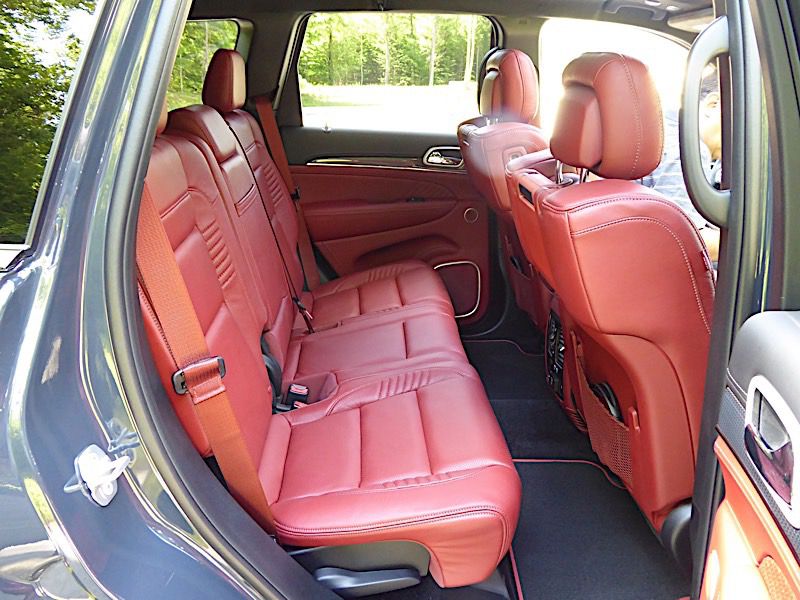
Photo by Ron Sessions
5) There are five drive modes.
The Trackhawk features five drive modes, selectable by a console knob. Auto mode delivers lighter steering effort, smooth shifts, a more compliant ride quality and a 40 percent front/60 percent rear 4WD torque split; it's the most comfortable for everyday driving. As its name implies, Sport mode cuts shift times in half, enables the paddle shifters, firms up steering effort and shock damping, and revises the 4WD system to a 35/65 front/rear split. Track mode initiates abrupt 160-millisecond shifts of the Torqueflite eight-speed automatic transmission, goes full-firm on suspension and steering, and makes a 30/70 front/rear 4WD split.
On the functionality front, the Trackhawk can pull a 7,200-lb trailer, and Tow mode modifies the throttle map for smooth launches and programs the Bilstein adaptive shock absorbers to counter fishtailing and up-and-down pitching. Lastly, Snow mode cuts the Trackhawk’s 707 horsepower by a few hundred ponies and delivers an even-Steven 50 percent front/50 percent rear 4WD torque split.
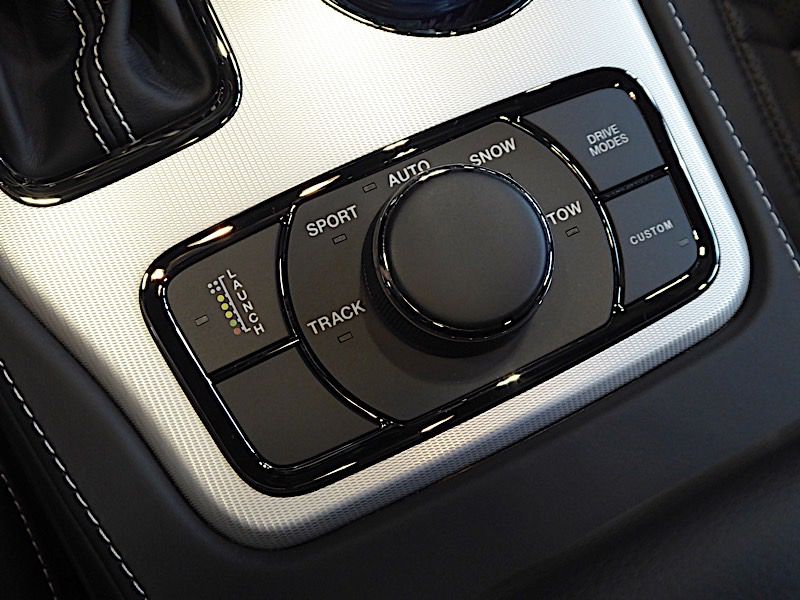
Photo by Ron Sessions
6) The Trackhawk has launch control.
Perhaps one of the most exciting features in the new Jeep Grand Cherokee Trackhawk is its standard launch control. Operated via a console button with an icon that resembles drag-strip Christmas tree starting lights, launch control enables flawless full-throttle acceleration just like the top drag racers.
After finding a safe location to try it out, select Track mode and shift the transmission to Drive. Then stand on the brake with your left foot, floor the gas pedal for a couple of seconds, and with the throttle buried and the Trackhawk pointed straight ahead, sidestep the brake and hang on. Just stab and steer and feel the enormous thrust of the blown 707-hp Hemi while doing your best Vin Diesel impersonation.
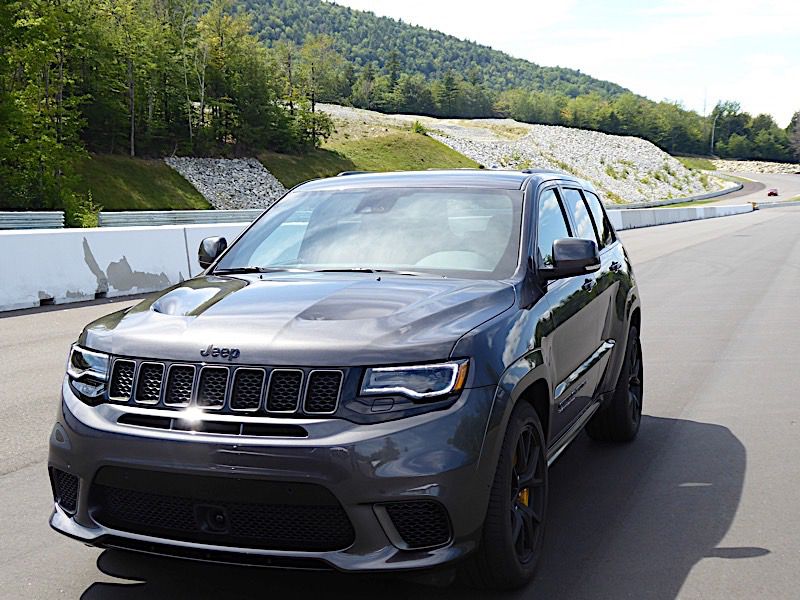
Photo by Ron Sessions
7) It handles and stops like a (big) GT car.
The Trackhawk’s standard full-time Quadra-Trac 4WD and sticky 295/45ZR20 Pirelli tires not only give the SUV tremendous bite in a straight line but also help deliver incredible control in the corners as well. Adaptive Bilstein shock absorbers adjust damping to keep the Jeep planted across a wide range of road and driving conditions.
Steering a precise line through those corners is aided by the Trackhawk’s electronically boosted rack-and-pinion system, which offers linear response but is a bit shy about providing road feel feedback on turn-in. And scrubbing speed off the 5,363-lb Trackhawk is quite confidence-inspiring thanks to its upsized Brembo brakes with directionally slotted rotors — the largest ever installed in a Jeep. The company claims that stops with the system take a sports-sedan-like 114 feet from 60 mph.
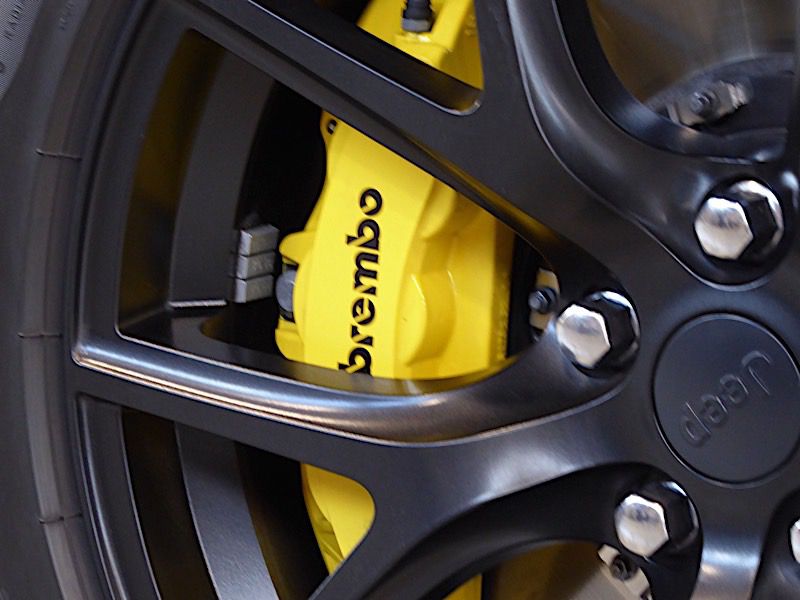
Photo by Ron Sessions
8) It reads the G-forces generated.
One cool feature that you won’t find in many vehicles is the Trackhawk’s G-force readout. It’s one of the several bits of interesting information that can be shown in the standard 7-inch multi-view display between the 200-mph speedometer and tachometer or on the dashboard infotainment screen.
In this case, my test drive generated lateral forces of 0.80g turning left, 0.83g turning right, 0.94g jumping on the binders and a whopping 1.15g storming away from a deserted rural stop sign — which may be a personal best.
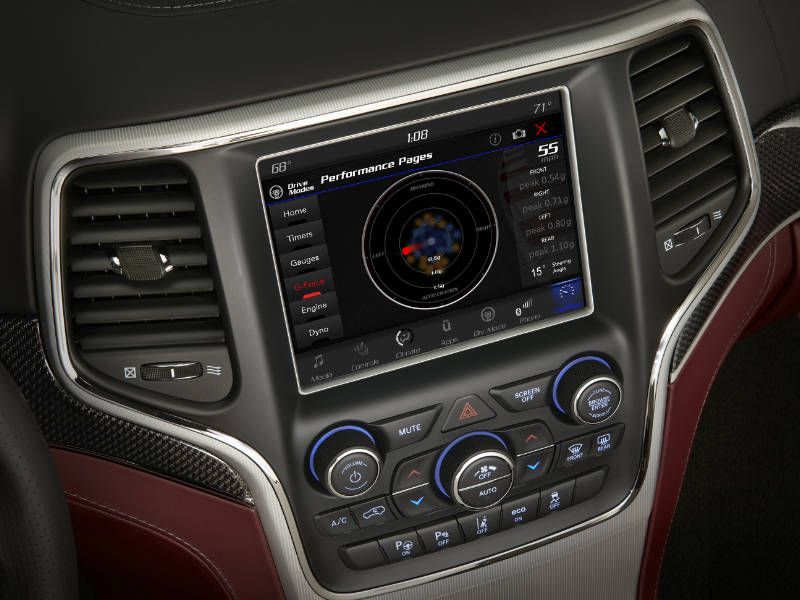
Photo by Jeep
9) Uconnect 4 is on board.
Jeep’s latest Uconnect 4 infotainment system with an 8.4-inch touchscreen display is standard equipment on the Trackhawk. It’s teamed with a 506-watt nine-speaker stereo or a ground-shaking 825-watt 19-speaker Harmon Kardon system. SiriusXM satellite radio and TravelLink are also onboard, along with a navigation system and smartphone integration via Apple CarPlay or Android Auto. The Performance Pages feature on the screen can display performance timers, as well as instantaneous horsepower and torque readouts.
Another cool feature on the screen is the Valet mode, which (after tapping in your own secret 4-digit PIN code) lets a “responsible” party set boundaries, which include trimming horsepower output and preventing stability control from being turned off, among others.
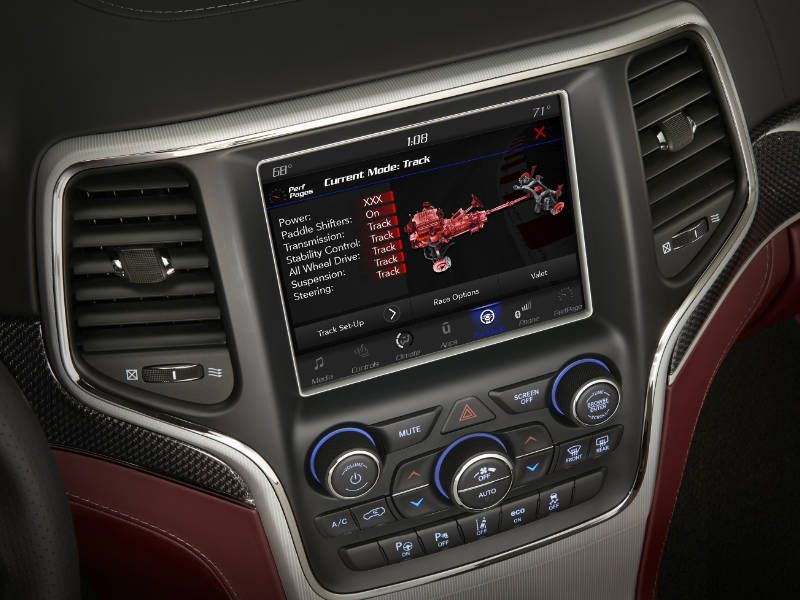
Photo by Jeep
10) It can run under the radar.
The real upside to driving the 2018 Jeep Grand Cherokee Trackhawk is that it can easily run under the radar until you desire to exercise its over-the-top performance capabilities. With a decidedly understated exterior, the performance envelope of the Trackhawk doesn’t reveal itself until you slip behind the wheel and step on the gas.
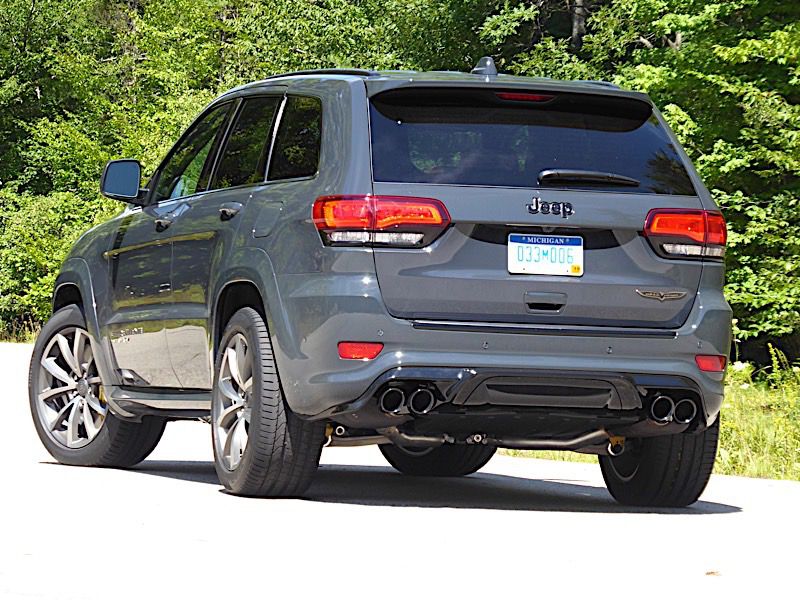
Photo by Ron Sessions